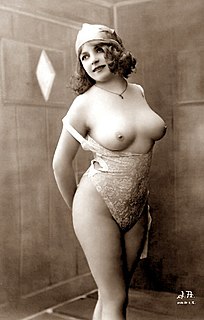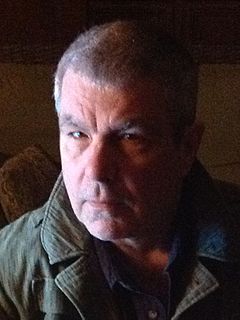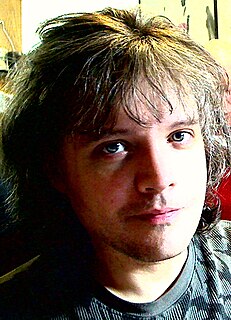
Erotica is any literary or artistic work that deals substantively with subject matter that is erotic, sexually stimulating or sexually arousing but is not generally considered to be pornographic. Erotic art may use any artistic form to depict erotic content, including painting, sculpture, drama, film or music. Erotic literature and erotic photography have become genres in their own right.

Underground comix are small press or self-published comic books that are often socially relevant or satirical in nature. They differ from mainstream comics in depicting content forbidden to mainstream publications by the Comics Code Authority, including explicit drug use, sexuality, and violence. They were most popular in the United States in the late 1960s and 1970s, and in the United Kingdom in the 1970s.
Peter Sotos is an American writer and musician. In his books, Sotos examines sadistic sexual criminals and sexually violent pornography, particularly involving children. His writings are interpreted by some as commenting on media hypocrisy around these issues. His books are often first person narratives, taking on the point of view of the sexual predator in order to explore sadistic and pedophilic sexual impulses.

Manuel Rodriguez, better known as Spain or Spain Rodriguez, was an American underground cartoonist who created the character Trashman. His experiences on the road with the motorcycle club, the Road Vultures M.C., provided inspiration for his work, as did his left-wing politics. Strongly influenced by 1950s EC Comics illustrator Wally Wood, Spain pushed Wood's sharp, crisp black shadows and hard-edged black outlines into a more simplified, stylized direction. His work also extended the eroticism of Wood's female characters.

witzend, published on an irregular schedule spanning decades, is an underground comic showcasing contributions by comic book professionals, leading illustrators and new artists. witzend was launched in 1966 by the writer-artist Wallace Wood, who handed the reins to Bill Pearson from 1968 to 1985. The title was printed in lower-case.

Adam Parfrey was an American journalist, editor, and the publisher of Feral House books, whose work in all three capacities frequently centered on unusual, extreme, or "forbidden" areas of knowledge. A 2010 Seattle Weekly profile stated that "what Parfrey does is publish books that explore the marginal aspects of culture. And in many cases—at least back when his interests were almost exclusively transgressive—he sheds light on subjects that society prefers to leave unexplored, carving a niche catering to those of us with an unseemly obsession with life's darkest, most depraved sides."

George Lawrence Petros is an American art designer, author, editor, interviewer and illustrator. From 1984 through 1992 he published and edited EXIT, a punk-inspired art and science fiction magazine he founded with Adam Parfrey and Kim Seltzer. From 1992 through 2000 he edited and art-directed Seconds, an all-interview music and culture magazine founded by Steven Blush. From 2000 through 2005 he was a contributing editor of Juxtapoz, the low-brow art magazine founded by Robert Williams, and the senior editor of Propaganda, a goth/industrial music and style magazine founded by Fred H. Berger. He is the author of Art That Kills: A Panoramic Portrait of Aesthetic Terrorism 1984-2001, The New Transsexuals: The Next Step In Human Evolution, and the editor of American Hardcore: A Tribal History.

Wendy PininéeFletcher, and Richard Pini are the husband-and-wife team responsible for creating the well-known Elfquest series of comics, graphic novels and prose works. They are also known as WaRP.
Ray Gun was an American alternative rock-and-roll magazine, first published in 1992 in Santa Monica, California. Led by founding publisher Marvin Scott Jarrett, art director David Carson and executive editor Randy Bookasta, along with founding editor Neil Feineman, Ray Gun explored experimental magazine typographic design and unique angles on the pop cultural currents of the 1990s. The editorial content was framed in a chaotic, abstract "grunge typography" style, not always readable, but distinctive in appearance. That visual tradition continued even after Carson left the magazine after three years; he was followed by a series of art directors, including Robert Hales, Chris Ashworth, Jason Saunby, Scott Denton-Cardew, and Jerome Curchod.

Art & Antiques is an American arts magazine.
Steven Cerio is an American artist, filmmaker, musician, writer, and composer whose unmistakable style set the stage for the neo-psychedelic revival in NYC. He has created his own loving and sarcastic expressions of joy for three decades.
Graphic design careers include creative director, art director, art production manager, brand identity developer, illustrator and layout artist.
The Duckberg Times was a free, alternative newspaper published in Washington, D.C., from January 1985 through 1990.
Brad Holland is an American artist. His work has appeared in Time, Vanity Fair, The New Yorker, Playboy, Rolling Stone, The New York Times, and many other national and international publications. His paintings have been exhibited in museums around the world, including one-man exhibitions at the Musée des Beaux-Arts, Clermont-Ferrand, France and the Museum of American Illustration, New York City.
Lloyd Dangle is an American writer and cartoonist, illustrator, and political satirist.
Bryce John Stevens is a horror writer, illustrator and editor. He grew up in Christchurch, New Zealand and moved to Sydney in the mid-1980s. From childhood he was fascinated with the supernatural and terrifying consequences of events from stories such as "The Tinderbox", a predilection which continued through his high school years and beyond.
Erich von Götha is the pseudonym of the British illustrator and comic book artist Robin Ray.
R.O. Blechman, is an American animator, illustrator, children's-book author, graphic novelist and editorial cartoonist whose work has been the subject of retrospectives at the Museum of Modern Art and other institutions. He was inducted into the Art Directors Hall of Fame in 1999.

Jason Vincent Brock is an American author, artist, editor and filmmaker.

Mishkafayim was a Hebrew-language art magazine published by the Israel Museum in Jerusalem from 1987 to 2001.










